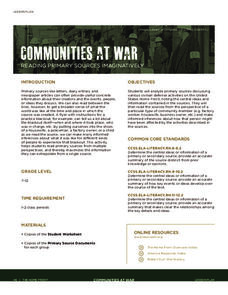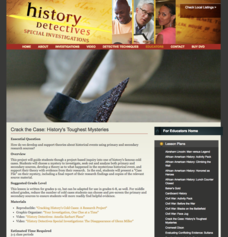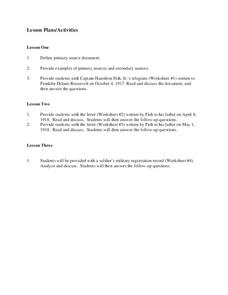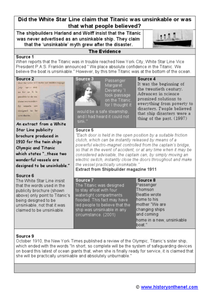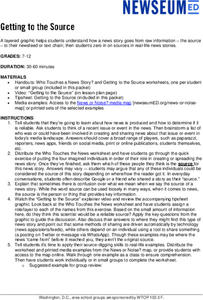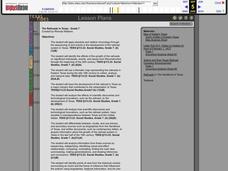National WWII Museum
Communities at War: Reading Primary Sources Imaginatively
Uncle Sam wants you to support the troops. Learners use an engaging lesson plan to analyze primary and secondary sources to discover what life was really like for American citizens at home during WWII. Pupils complete worksheets, group...
PBS
Crack the Case: History's Toughest Mysteries
Young sleuths don their trench coats, tip their fedoras, and grab their notepads to investigate one of four famous unsolved mysteries. After examining multiple primary and secondary sources related to their cold case, they propose a...
Curated OER
Friar Margil and the Spanish Missions
Seventh graders review the differences between primary and secondary sources. They are told that the Father Margil illustration can be used as a primary source. Students define the terms "assimilation" and "diversity." They use...
mdk12.org
Primary Source Quadrant Cards
Young historians can use this simple graphic organizer to define primary source and list both examples and non-examples of the term. A similar resource can also be constructed for secondary sources!
Curated OER
Primary vs. Secondary Sources Notes
What’s the difference between primary and secondary source materials? Here’s a handout, designed as a reference for learners, that does a good job of distinguishing between primary and secondary source materials and providing examples of...
Ford's Theatre
How Perspective Shapes Understanding of History
The Boston Massacre may be an iconic event in American history, but perhaps the British soldiers had another point of view. Using primary sources, including reports from Boston newspapers and secondary sources from the British...
Curated OER
Primary and Secondary Sources
Students understand what primary and secondary sources are. In this primary and secondary sources instructional activity, students take a list of sources and break down to primary and secondary sources.
Curated OER
Understanding Primary and Secondary Sources
Students identify legends in Tennessee and U.S. history, and differentiate between primary and secondary sources. They list examples of primary and secondary sources, participate in a field trip to the Country Music Hall of Fame, and...
Curated OER
Primary and Secondary Sources
Learners complete worksheets having to do with primary and secondary source documents. In this sources lesson, students define a primary source document, look at examples of primary and secondary sources. Learners complete multiple...
New York State Education Department
Global History and Geography Examination: August 2011
The Mongols, Spanish, and Ottomans all rewrote history with their conquest and control of empires. Yet, each made its mark differently. Using a variety of secondary and primary sources, pupils consider the similarities and differences...
Curated OER
The Real World Revisited
Class members participate in a series of hands on, online, and multimedia activities to identify the difference between primary and secondary sources. They watch a related video and visit a variety of sites to locate primary and...
Shmoop
ELA - Literacy.CCSS.ELA-Literacy.RH.9-10.1
Do your pupils know what a primary source is? How about a secondary source? Provide them with the information here about different types of documents and then test their knowledge with a brief quiz. The quiz is made up of two documents....
Curated OER
Transparency Review
Students investigate and distinguish between primary and secondary sources when analyzing works of literature. They present their information on transparencies that are displayed to the class.
Curated OER
Reformers versus Residents in Five Points: A Role Play
Social Studies and role-playing can go hand in hand. Learners use supporting evidence found in primary and secondary source material to develop a character from the Five Points neighborhood in the 1850s. Each student takes on the role of...
Smithsonian Institution
Mary Henry: Journal/Diary Writing
A great way to connect social studies with language arts, a resource on Mary Henry's historical diary reinforces the concepts of primary and secondary sources. It comes with an easy-to-understand lesson plan, as well as the reference...
New York State Education Department
Global History and Geography Examination: June 2011
People in Ukraine, Rwanda, and Cambodia have all faced challenges to their human rights and even genocide. Using primary and secondary sources, scholars evaluate these challenges and the international community's role in them. The...
Curated OER
White Star Line and the Titanic
Was the Titanic advertised as an unsinkable ship, or was it just what the public believed? In this analysis activity, historians examine both primary and secondary sources to determine the answer to this question and the reliability of...
American Battlefield Trust
Joshua Chamberlain Lesson Plan
While Joshua Chamberlain's name is not as iconic as Abraham Lincoln or Robert E. Lee, he still played a pivotal role in the military engagements of the Civil War. Using two secondary sources—including one that draws heavily from his...
Library of Virginia
You are Clever Enough to Examine a Historical Source!
Your students are obviously clever, but now they can be C-L-E-V-E-R! Enhance a research project with an exercise that prompts learners to identify the creator, location, era, and value of the information source, as well as provide an...
Briscoe Center for American History
Identifying Primary Source Documents
Who is Mary Maverick and why is she important? the focus of this, the second in a series of five lessons that are designed to introduce middle schoolers to how historians use primary source documents to understand the past, is on how to...
Newseum
Getting to the Source
Reliable news stories are based on facts from reliable sources. Young journalists learn how to evaluate the reliability of news sources by watching a short explainer video. Teams apply their new source-digging skills to a current news...
Curated OER
The Railroads in Texas
Seventh graders differentiate between, locate, and use primary and secondary sources, such as biographies from the Handbook of Texas. They analyze the effects of scientific discoveries and technological innovations, such as the railroad,...
Curated OER
Primary/Secondary Source Activity
In this primary/secondary source activity, students answer a set of 5 questions about a picture drawn in approximately 1934 of an event that took place in 1867.
Center for History and New Media
A Look at Virginians During Reconstruction, 1865-1877
The transition between rebellion to reunification was not smooth after the Civil War. Young historians compare primary and secondary source documents in a study of the Reconstruction era in Virginia, noting the rights that were not...


